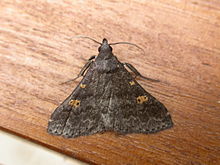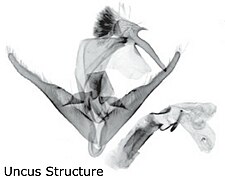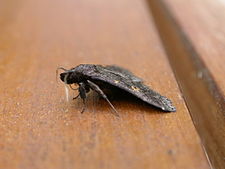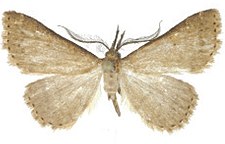| Naarda | |
|---|---|

| |
| Naarda xanthonephra | |
| Scientific classification | |
| Domain: | Eukaryota |
| Kingdom: | Animalia |
| Phylum: | Arthropoda |
| Class: | Insecta |
| Order: | Lepidoptera |
| Superfamily: | Noctuoidea |
| Family: | Erebidae |
| Subfamily: | Herminiinae |
| Genus: | Naarda Walker, 1866 |
| Type species | |
| Naarda bisignata Walker, 1866 | |
| Species | |
|
Multiple, see text | |
| Synonyms | |
| |









Naarda is a large genus of erebid moths which currently encompasses 108 species. Initially identified by Francis Walker in 1866, it is in the family Erebidae. Somewhat ruddy in appearance, this genus is primarily distinguishable for its generally slender thorax and abdomen, and straight, porrect labial palpi. Most species are dark beige, but shading can reach a deep charcoal. Most species possess muddy yellow, reniform, orbicular stigmata featured on the forewings, which is reflected bilaterally superior on some species (though these may be significantly more minute and successively annular).
Physical features
The wingspan is between 19-22mm, dependent on the species.
The rami of the antenna are, at the maximum of its width, 9-10 times longer than the axis of the antenna, and the apical segments lack the rami.
Aside from the elongated and easily recognizable porrect labial palpi of both sexes, (which are usually 5 times as long as the diameter of the eye, with the tertiary segment comparatively longer), and the relatively broad forewings with straight and even costa, substantial dissimilarity is present in the male sex.
Male
The most prominent autapomorphy is the uncus structure, which resembles the head of a long-billed bird. The uncus has a large, rounded subbasal dorsal bulb bearing a small, acute frontal spine and a large group of long hairs standing apart, (in the likeness of a forelock), and a long, straight, atypically dilated rounded distal section.
Other recurrent traits of the clasping apparatus across the entirety of the Naarda genus include the substantially broad tegumen; the well-developed and stout transtilla; and the variably broad, generally triangular valvae. The entire structure resembles a flying bird.
The phallus is short, straight, and thick; the vesica is inflated and basally broad. In most species, the ductus ejaculatoris is directed forward in the axis of the phallus. The cornutus is variably large, and its texture resembles that of a sponge cake.
Range
Of the 108 known species, virtually the entirety have been discovered in Asia, Southeast Asia, and Africa, but a handful are in the northern Australian region.
Countries where Naarda genus has been documented:
- Angola
- Australia
- Borneo
- Burma
- Celebes
- China
- India
- Indonesia
- Japan
- Laos
- Madagascar
- Malawi
- Nepal
- New Guinea
- Nigeria
- Philippines
- Somalia
- South Africa
- Sri Lanka
- Sumatra
- Taiwan
- Tanzania
- Uganda
- Vietnam
Species list
- Naarda abnormalis Hampson, 1912
- Naarda acolutha Holloway, 2008 (Borneo)
- Naarda albopunctalis Rothschild, 1915 (New Guinea)
- Naarda albostigma Rothschild, 1915 (New Guinea)
- Naarda alternata Tóth & Ronkay, 2015 (Indonesia, Philippines, Thailand)
- Naarda annulata Tóth & Ronkay, 2015 (China)
- Naarda ardeola Tóth & Ronkay, 2015 (Thailand)
- Naarda ascensalis Swinhoe
- Naarda atrata Tóth & Ronkay, 2015 (Thailand)
- Naarda atrirena (Hampson, 1912) (Sri Lanka)
- Naarda aurea Tóth & Ronkay, 2015 (Nepal)
- Naarda bankhomensis Tóth & Ronkay, 2015 (Vietnam)
- Naarda barlowi Holloway, 2008 (Borneo)
- Naarda bicolora Tóth & Ronkay, 2015 (Cambodia)
- Naarda bipunctata Tóth & Ronkay, 2015 (Thailand)
- Naarda bisignata Walker, 1866 (Indonesia)
- Naarda blepharota (Strand, 1920) (Taiwan)
- Naarda caesia Tóth & Ronkay, 2015 (Sumatra)
- Naarda calliceros Turner, 1932 (Australia)
- Naarda calligrapha Tóth & Ronkay, 2015 (India, Burma and Indonesia)
- Naarda capreola Tóth & Ronkay, 2015 (Cambodia)
- Naarda cinerea Tóth & Ronkay, 2015 (Taiwan)
- Naarda cingulata Tóth & Ronkay, 2015 (Thailand)
- Naarda clitodes D. S. Fletcher, 1961 (Uganda)
- Naarda coerulea Tóth & Ronkay, 2015 (Nepal, Vietnam)
- Naarda conifera Tóth & Ronkay, 2015 (Nepal)
- Naarda costicorna Tóth & Ronkay, 2015 (Philippines)
- Naarda crassipes Tóth & Ronkay, 2015 (Thailand)
- Naarda curiosipalpa Tóth & Ronkay, 2015 (Philippines)
- Naarda dentata Tóth & Ronkay, 2015 (Nepal, China)
- Naarda digitata Tóth & Ronkay, 2015 (Taiwan)
- Naarda egrettoides Tóth & Ronkay, 2015 (Thailand)
- Naarda felinopsis Tóth & Ronkay, 2015 (Vietnam)
- Naarda flavisignata Vari, 1962 (South Africa)
- Naarda fuliginaria (Bethune-Baker, 1911) (Angola)
- Naarda fulvirena Tóth & Ronkay, 2015 (Nepal)
- Naarda fulvirenoides Tóth & Ronkay, 2015 (Thailand)
- Naarda furcatella Tóth & Ronkay, 2015 (Cambodia, Sumatra, Thailand)
- Naarda furcipalpa Tóth & Ronkay, 2015 (Brunei)
- Naarda fuscicosta (Hampson, 1891) (India)
- Naarda gigaloba Tóth & Ronkay, 2015 (Sri Lanka)
- Naarda glauculalis Hampson, 1893 (Sri Lanka)
- Naarda hallasana Tóth & Ronkay, 2015 (Korea)
- Naarda hastata Tóth & Ronkay, 2015 (Thailand, Vietnam)
- Naarda hoenei Tóth & Ronkay, 2015 (China)
- Naarda huettleri Tóth & Ronkay, 2015 (Sri Lanka)
- Naarda icterica (D. S. Fletcher, 1961) (Uganda)
- Naarda imitata Tóth & Ronkay, 2015 (Cambodia)
- Naarda ineffectalis (Walker, ) (Sri Lanka, Borneo)
- Naarda inouei Tóth & Ronkay, 2015 (Nepal, India)
- Naarda ivelona Viette, 1965 (Madagascar)
- Naarda jucundalis (Snellen, 1880) (Celebes)
- Naarda lancanga Deng & Han, 2011
- Naarda laoana Tóth & Ronkay, 2015 (Laos)
- Naarda laufellalis (Walker, 1859) (Borneo)
- Naarda leptovalva Tóth & Ronkay, 2015 (Nepal)
- Naarda leptosigna Tóth & Ronkay, 2015 (Sri Lanka)
- Naarda leptotypa Turner, 1932
- Naarda leucopis Hampson, 1902 (South Africa)
- Naarda lingualis Tóth & Ronkay, 2015 (China)
- Naarda maculifera (Staudinger, 1892)
- Naarda magnifica Tóth & Ronkay, 2015 (Thailand)
- Naarda marginata Holloway, 2008 (Borneo)
- Naarda melanomma Hampson, 1902 (South Africa)
- Naarda melinau Holloway, 2008 (Borneo)
- Naarda melistigma Tóth & Ronkay, 2015 (Taiwan)
- Naarda mirabilis Tóth & Ronkay, 2015 (Vietnam)
- Naarda molybdota (Hampson, 1912) (India)
- Naarda muluensis Holloway, 2008 (Borneo)
- Naarda murina Tóth & Ronkay, 2015 (Thailand)
- Naarda nepalensis Tóth & Ronkay, 2015 (Nepal)
- Naarda nigripalpis Hampson, 1916 (Somalia)
- Naarda nigrissima Tóth & Ronkay, 2015 (Cambodia, Thailand and Taiwan)
- Naarda nodariodes Prout, 1928 (Borneo)
- Naarda notata Hampson, 1891
- Naarda numismata Tóth & Ronkay, 2015 (India)
- Naarda nymphoida Tóth & Ronkay, 2015 (Vietnam)
- Naarda ochreistigma Hampson, 1893
- Naarda ochronota Wileman, 1915 (Taiwan)
- Naarda octogesima Tóth & Ronkay, 2015 (Thailand)
- Naarda palawana Tóth & Ronkay, 2015 (Philippines)
- Naarda pallida Tóth & Ronkay, 2015 (Indonesia)
- Naarda pectinata Sugi, 1982 (Japan)
- Naarda penicula Tóth & Ronkay, 2015 (China)
- Naarda picata Tóth & Ronkay, 2015 (Taiwan)
- Naarda plenirena de Joannis, 1929 (Vietnam)
- Naarda plumbea Tóth & Ronkay, 2015 (Nepal)
- Naarda pocstamasi Tóth & Ronkay, 2015 (Vietnam)
- Naarda postpallida de Joannis, 1929 (Vietnam)
- Naarda punctirena (Sugi, 1982)
- Naarda purpurea Tóth & Ronkay, 2015 (Laos)
- Naarda purpurisigna (Holloway, 2008)
- Naarda secreta Tóth & Ronkay, 2015 (Taiwan)
- Naarda serra Holloway, 2008 (Borneo)
- Naarda sonibacsi Tóth & Ronkay, 2015 (Nepal)
- Naarda spinivesica Tóth & Ronkay, 2015 (Taiwan)
- Naarda sumatrana Tóth & Ronkay, 2015
- Naarda submuluensis Holloway, 2008 (Borneo)
- Naarda symethusalis (Walker, 1859)
- Naarda tandoana (Bethune-Baker, 1911) (Angola)
- Naarda tenuifascia Tóth & Ronkay, 2015 (Vietnam)
- Naarda tetramacula Tóth & Ronkay, 2015 (Sumatra)
- Naarda truncata Tóth & Ronkay, 2015 (Philippines)
- Naarda umbria Hampson, 1902 (Sri Lanka)
- Naarda unipunctata Bethune-Baker, 1911 (Nigeria)
- Naarda uthanti Tóth & Ronkay, 2015 (Burma)
- Naarda variegata Tóth & Ronkay, 2015 (Taiwan)
- Naarda vicina Tóth & Ronkay, 2015 (Philippines)
- Naarda xanthonephra Turner, 1908 (Australia)
- Naarda xanthopis Hampson (South Africa)
References
- "Naarda (genus)". BayScience Foundation, Inc. 2004–2008. Retrieved 2008-08-20.
- "Gynaephila". Mindat. Hudson Institute of Mineralogy. Retrieved 5 May 2021.
{{cite web}}: External link in|ref= - ^ Tóth, Balázs (23 February 2018). "New data on the taxonomy, morphology and distribution of Naarda ineffectalis (Walker, 1859) (Lepidoptera, Erebidae, Hypeninae)" (PDF). Nota Lepidopterologica. 41 (1): 99–106. doi:10.3897/nl.41.21584.
- Savela, Markku (February 24, 2012). "Naarda Walker, 1866". Lepidoptera and Some Other Life Forms. Retrieved February 4, 2020.
- ^ Tóth, Balázs; Ronkay, László (27 February 2015). "Revision of the Palaearctic and Oriental species of the genus Naarda Walker, 1866 (Lepidoptera: Erebidae, Hypeninae). Part 5. Description of 13 new species from Asia". Zootaxa. 3925 (2): 179–201. doi:10.11646/zootaxa.3925.2.2. PMID 25781738.
- "Naarda Walker, 1866". AfroMoths. Retrieved 5 May 2021.
- ^ Tóth, Balázs; Ronkay, Laslo (15 June 2014). "Revision of the Palaearctic and Oriental species of the genus Naarda Walker, 1866 (Lepidoptera, Erebidae, Hypeninae). Part 3. Description of three new species from Asia". Nota Lepidopterologica. 37 (1): 9–18. doi:10.3897/nl.37.7957.
- "NAARDA Genus Details". Natural History Museum. NHM. Retrieved 5 May 2021.
- "Naarda fuliginaria". Google Info. Retrieved 5 May 2021.
- "Naarda Walker, 1866". Atlas of Living Australia. Retrieved 5 May 2021.
- "SUBFAMILY HERMINIINAE". Moths of Borneo. Southdene Syndication. Retrieved 5 May 2021.
- "Naarda Walker, 1866". Funet.fi. Funet. Retrieved 5 May 2021.
- Deng, Gang; Han, Hui-Lin (2011). "A new species of Naarda from Southwest China (Lepidoptera, Noctuidae, Hypeninae)". Tinea. 21 (5): 256–258. NAID 40019130752.
- Vattakhaven, Thomas. "Naarda molybdota Hampson, 1912". Biodiversity India. Biodiversity Infomatics Program. Retrieved 5 May 2021.
- Tóth, B.; Ronkay, L. (2015). "Revision of the Palaearctic and Oriental species of the genus Naarda (Lepidoptera: Erebidae, Hypeninae). Part 2. Description of ten new species from Asia". Acta Zoologica Academiae Scientiarum Hungaricae. 61 (1): 3–23. doi:10.17109/AZH.61.1.3.2015. hdl:2437/220487.
- "Naarda ivelona". Minday. Mindat. Retrieved 5 May 2021.
- "Naarda melanomma Hampson, 1902". AfricanMoths. African Moths. Retrieved 5 May 2021.
- Tóth, Balázs; Ronkay, László (3 April 2014). "Revision of the Palaearctic and Oriental species of the genus Naarda Walker (Lepidoptera: Erebidae, Hypeninae). Part 1. Taxonomic notes and description of 28 new species from eastern and southeastern Asia". Oriental Insects. 48 (1–2): 1–49. doi:10.1080/00305316.2014.959790. S2CID 86481569.
- "Naarda Walker". Moths of Borneo. Southdene Syndications. Retrieved 5 May 2021.
- International Catalogue of Scientific Literature, 1901-1914, Volumes 8-10 (10 ed.). New Jersey: Mini-Print Corporation. January 1914. p. 362. Retrieved 5 May 2021.
- Tóth, Balázs; Ronkay, László (2015). "Revision of the Palaearctic and Oriental species of the genus Naarda (Lepidoptera: Erebidae, Hypeninae). Part 2. Description of ten new species from Asia". Acta Zoologica Academiae Scientiarum Hungaricae. 61 (1): 3–23. doi:10.17109/AZH.61.1.3.2015. hdl:2437/220487.
- ^ "Naarda nigripalpis Hampson, 1916". AfricanMoths. AfricanMoths.com. Retrieved 5 May 2021.
- "Naarda melanomma Hampson, 1902". AfricanMoths. African Moths. Retrieved 5 May 2021.
- "CHECKLIST". MothsofBorneo. Moths of Borneo. Retrieved 5 May 2021.
- Tóth, Balázs (June 2019). "Notes on the species of Naarda Walker, 1866 (Lepidoptera: Erebidae, Hypeninae) from mainland China, with the description of a new species and establishment of a new synonymy". Journal of Asia-Pacific Entomology. 22 (2): 437–442. doi:10.1016/j.aspen.2019.02.004. S2CID 92807955.
- "Naarda Walker, 1866". AfroMoths. Retrieved 5 May 2021.
Further reading
- Tóth, Balázs; Ronkay, László (3 April 2014). "Revision of the Palaearctic and Oriental species of the genus Naarda Walker (Lepidoptera: Erebidae, Hypeninae). Part 1. Taxonomic notes and description of 28 new species from eastern and southeastern Asia". Oriental Insects. 48 (1–2): 1–49. doi:10.1080/00305316.2014.959790. S2CID 86481569.
- Tóth, B.; Ronkay, L. (2015). "Revision of the Palaearctic and Oriental species of the genus Naarda (Lepidoptera: Erebidae, Hypeninae). Part 2. Description of ten new species from Asia". Acta Zoologica Academiae Scientiarum Hungaricae. 61 (1): 3–23. doi:10.17109/AZH.61.1.3.2015. hdl:2437/220487.
- Tóth, Balázs; Ronkay, Laslo (15 June 2014). "Revision of the Palaearctic and Oriental species of the genus Naarda Walker, 1866 (Lepidoptera, Erebidae, Hypeninae). Part 3. Description of three new species from Asia". Nota Lepidopterologica. 37 (1): 9–18. doi:10.3897/nl.37.7957.
- Tóth, Balázs; Ronkay, László (June 2015). "Revision of the Palaearctic and Oriental species of Naarda Walker (Lepidoptera: Erebidae, Hypeninae). Part 4. Description of nine new species". Journal of Asia-Pacific Entomology. 18 (2): 253–262. doi:10.1016/j.aspen.2015.02.001.
- Tóth, Balázs; Ronkay, László (27 February 2015). "Revision of the Palaearctic and Oriental species of the genus Naarda Walker, 1866 (Lepidoptera: Erebidae, Hypeninae). Part 5. Description of 13 new species from Asia". Zootaxa. 3925 (2): 179–201. doi:10.11646/zootaxa.3925.2.2. PMID 25781738.
![]() Media related to Naarda at Wikimedia Commons
Media related to Naarda at Wikimedia Commons
| Taxon identifiers | |
|---|---|
| Naarda | |